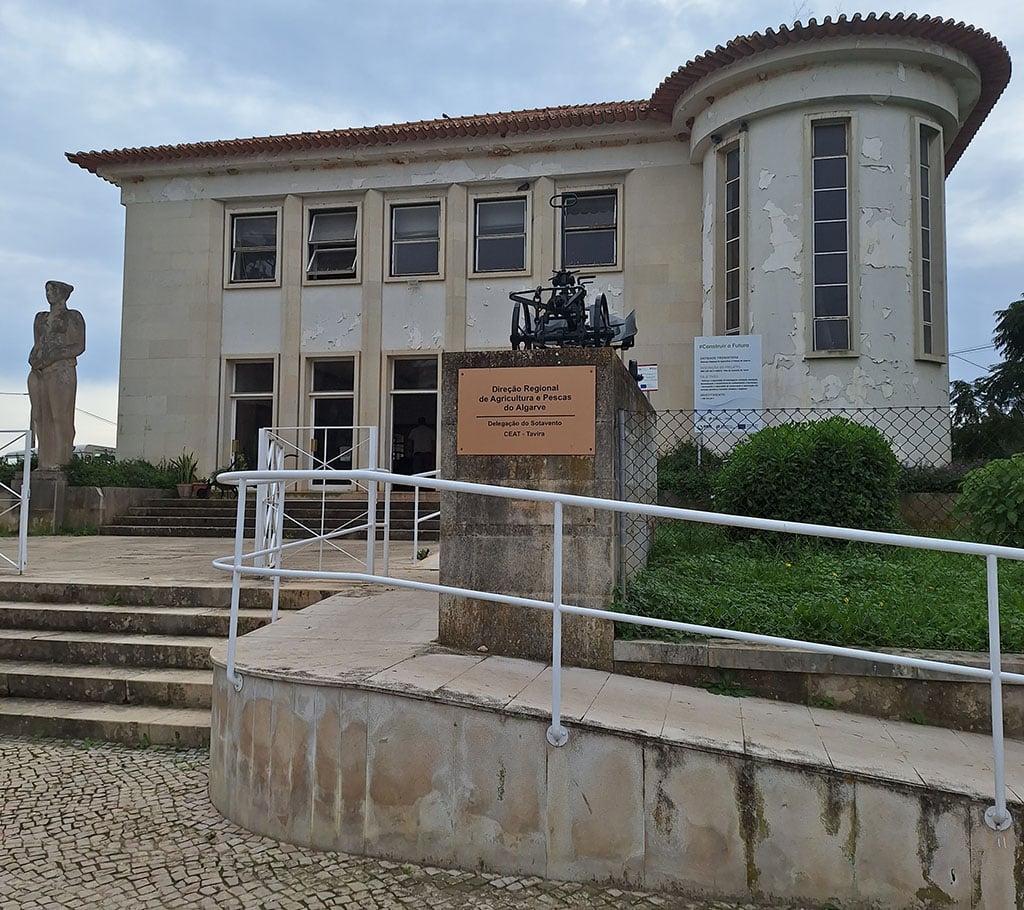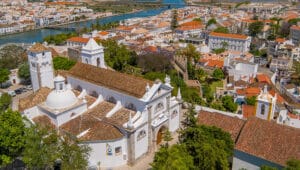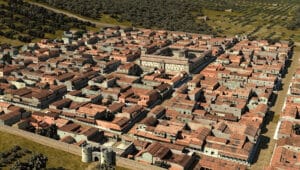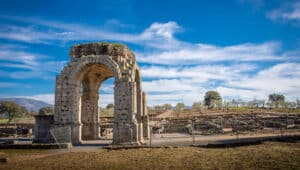Flora
Marking its past as a garrison town, the bronze statue of a young woman on the roundabout opposite the railway station in Tavira waves goodbye to her soldier husband near the entrance to the station.
Overlooking the roundabout to the south is the old the Posto Agrário (currently the Centro de Experimentação Agrária) with its own tall female statue. This statue has long intrigued me. I wondered how old it was, whom it represented and who was the sculptor.
The Agriculture Station was planned in the days of the First Republic, and its building was designed by Jorge Segurado in the 1940s, completed in the late 50s and was in service by 1962. The style of its architecture is from the Estado Novo and using the Algarvian style of the four-waters roof. The building represented a conscious move away from modern ideas and presents a noble and neoclassical frontage towards the town of Tavira.
Flora, the tall, sculptured statue in front of the square office block, represents the flora of the Algarve and was erected in 1959. The sculptor was Salvador Barata Feyo, professor at the Escola de Belas Artes do Porto as well as Director of the Museu Nacional de Soares dos Reis. His work was much in demand in the Portugal of the 1940s and 50s. Flora epitomised one of the aims of the Posto Agrário, which was to encourage the local production of flowers.

Guilhermina Madeira
As Guilhermina Madeira began training for her professional work in 1967, she began seven years of intensive work in the cultivation of carnations at the Tavira Agricultural Station. This experimental station produced several varieties of carnations and sold the produce to various places.
In addition to carnations, the greenhouses there also produced “tulips, gladioli and other flowers, as well as vegetables. And every week, on Mondays, Wednesdays and Fridays, baskets of carnations were sent to Lisbon. They came here to pick them up, and we sold them to Lisbon, to a distributor,” said Guilhermina.
On Thursday, April 25, 1974, she saw on television images of carnations in the rifles and lapels of the soldiers who led the revolution and in the hands of many of the people who joined them in downtown Lisbon. Guilhermina confesses that she had no idea that those flowers were the same ones that had been grown in Tavira and that, days before, she had picked them.
“Like everyone else, we saw the flowers here on television. That week, between April 25 and May 1, Sr Laranjeira, who received our flowers in Lisbon, called here to ask us to send as many carnations as we could, especially red ones,” according to Guilhermina.
She recalls that the Lisbon flower merchant spoke to Sr Assunção, who was the deputy director of the agricultural station and was responsible for the production of flowers. And, in their conversation, he informed him that “he was the one who supplied the florists in Rossio with the carnations that were sold on April 25. That was how we found out.”
These flowers were the children of Tavira, and without them the Carnation Revolution could not have taken place, and the military coup would today be remembered quite differently.
This was not the first time that the carnations from the Tavira Agricultural Station were associated with a significant event in the history of Portugal. At the time, there were not many carnation producers in Portugal, and the production that was carried out in Tavira had “very innovative” characteristics.
Guilhermina revealed: “In conversation with my husband, I remembered that when Pope Paul VI came to Fátima in 1967, the float of Our Lady was covered with white carnations that had been grown here and sent to the north.”
After graduating as an agricultural manager, Guilhermina later qualified as a lawyer, and established her practice in Évora.
Celeste Caeiro
News reports on November 23 revealed that Celeste Caeiro, the woman who began to distribute red carnations to soldiers on their way to ending Portugal’s 40-year right-wing dictatorship, had died at the age of 91. Her death occurred just seven months after the 50th anniversary of the nearly bloodless military coup and triggered an outpouring of sorrow and gratitude both online and in official statements.
The story of how the carnation became a symbol of the Revolution is well known and was often told by Celeste, its main character. At the time in Lisbon, she worked in a modern self-service restaurant as a cloakroom attendant. For that particular day, April 25, 1974, Celeste’s boss had ordered carnations to give to customers in celebration of the first anniversary of his restaurant. But that morning, as he listened to an uncensored radio station, he learned that a military rising was taking place and decided to keep the restaurant closed.
He, therefore, gave the bunches of flowers to his employees so that they would not go to waste. And so it was that the carnations purchased that morning at the Mercado da Ribeira in Lisbon for the benefit of customers of her restaurant were kept by Celeste.
On her way back home, she decided to see what was happening near the Carmo. And as she passed through the Rua do Carmo, she started talking to a soldier on top of a Chaimite (an armoured personnel carrier), and he eventually asked her for a cigarette. As she did not smoke, she had no cigarettes, but she did have a bunch of carnations, and so she gave him a flower instead of a cigarette. He accepted the flower and placed it in the barrel of his rifle.
The idea soon caught on, and the remaining carnations were distributed to other soldiers and people who were on the street. The act was imitated by others who distributed their carnations, and soon other soldiers were inserting the flowers in their gun barrels.
Photographers captured pictures that came to symbolise the successful military coup.
As the journalist Hélio Carvalho recently remarked, “The most beautiful moment of our democracy would not have been as beautiful without Celeste Caeiro. Thank you for everything.”
Behind the events of Thursday, April 25, 1974, stand three women – Flora, Guilhermina and Celeste, without each of whom the Carnations of April would never have happened. And the staff at the Centro de Experimentação Agrária de Tavira plan to cultivate, select and distribute the Tavira grown carnations on April 25 next year in remembrance of that historic day half a century ago.
By Peter Booker
|| features@portugalresident.com
Peter Booker co-founded with his wife Lynne the Algarve History Association.
www.algarvehistoryassociation.com

























